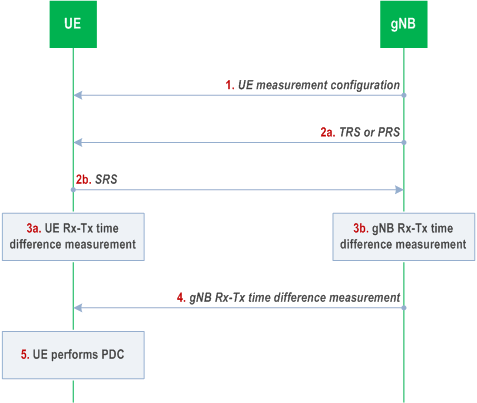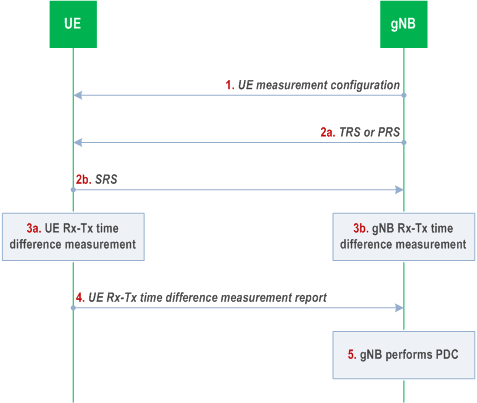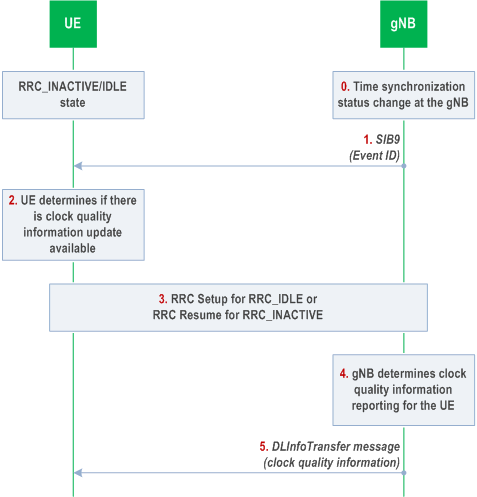Content for TS 38.300 Word version: 18.3.0
1…
4…
4.7…
5…
5.3…
5.4…
6…
6.2…
6.6…
7…
8…
9…
9.2.2…
9.2.2.5…
9.2.3…
9.2.3.2…
9.2.3.3…
9.2.4…
9.2.6…
9.3…
10…
11…
15…
15.5…
16…
16.2…
16.3…
16.4…
16.8…
16.9…
16.10…
16.12…
16.12.5…
16.12.6…
16.12.6.3
16.12.7
16.13…
16.14…
16.15…
16.18…
16.19…
16.21…
16.21.3…
17…
18…
19
20…
21…
A…
B…
C…
G…
16.8 Support for Time Sensitive Communications
16.8.1 General
16.8.2 Network timing synchronization status monitoring
16.8.2.1 General
16.8.2.2 Network timing synchronization status monitoring towards CN
16.8.2.3 Network timing synchronization status monitoring towards UE
16.8.3 RAN feedback for adaptation of Burst Arrival Time and Periodicity
...
...
16.8 Support for Time Sensitive Communications |R16| p. 162
16.8.1 General |R18| p. 162
Time Sensitive Communications (TSC), as defined in TS 23.501, is a communication service that supports deterministic communication and/or isochronous communication with high reliability and availability. Examples of such services are the ones in the area of Industrial Internet of Things, e.g. related to cyber-physical control applications as described in TS 22.104.
To support strict synchronization accuracy requirements of TSC applications, the gNB may signal 5G system time reference information to the UE using unicast or broadcast RRC signalling with a granularity of 10 ns. Uncertainty parameter may be included in reference time information to indicate its accuracy. The UE may indicate to the gNB a preference to be provisioned with reference time information using UE Assistance Information procedure. Propagation delay compensation (PDC) mechanisms may be applied based on RTT or TA, and can be performed at the UE or gNB side. When performed at UE side, the PDC mechanisms are controlled via RRC signalling by the gNB.
The RTT-based PDC mechanism is achieved by using Rx-Tx time difference measurements of a single pair of configured TRS/PRS and SRS. The following Figure describes the signalling procedures of UE-side RTT-based PDC:

Step 1.
The following Figure describes the signalling procedures of gNB-side RTT-based PDC:
The gNB provides measurement configurations to the UE;
Step 2a/b.
The gNB transmits TRS or PRS to the UE for measurements, and the UE transmits SRS to the gNB for measurement;
Step 3a/b.
Both the UE and the gNB perform Rx-Tx time difference measurements;
Step 4.
The gNB provides its Rx-Tx time difference measurement to the UE;
Step 5.
The UE performs PDC based on Rx-Tx time difference measurements from itself and the gNB.

Step 1.
The gNB may also receive TSC Assistance Information (TSCAI), see TS 23.501, from the Core Network, e.g. during QoS flow establishment, or from another gNB during handover. TSCAI contains additional information about the traffic flow such as burst arrival time, burst periodicity, and survival time. TSCAI knowledge may be leveraged in the gNB's scheduler to more efficiently schedule periodic, deterministic traffic flows either via Configured Grants, Semi-Persistent Scheduling or with dynamic grants, and/or to improve the associated link reliability to meet the survival time requirement (see TS 22.104).
To support uplink periodic traffics of services with survival time requirement, configured grant resources can be used such that the mapping relation between the service and the configured grant is known to both gNB and UE, thus allowing the gNB to use configured grant retransmission scheduling (addressed by CS-RNTI) to trigger survival time state entry for the corresponding DRB. Upon survival time state entry, all RLC entities configured for the DRB are activated by the UE for duplication to prevent failure of subsequent messages and hence fulfilling the survival time requirement. If CA or DC duplication for the DRB is already activated, the DRB should enter survival time state when any retransmission grant for any of its active LCHs is received.
The gNB provides measurement configurations to the UE;
Step 2a/b.
The gNB transmits TRS or PRS to the UE for measurements, and the UE transmits SRS to the gNB for measurement;
Step 3a/b.
Both the UE and the gNB perform Rx-Tx time difference measurements;
Step 4.
The UE reports its Rx-Tx time difference measurement to the gNB;
Step 5.
The gNB performs PDC based on Rx-Tx time difference measurements from itself and the UE.
16.8.2 Network timing synchronization status monitoring |R18| p. 164
16.8.2.1 General p. 164
While time synchronization service is offered by the 5GS, the network timing synchronization status of the gNB may change. The gNB detects timing synchronization degradation or improvement locally and informs the consumer of the information as specified in TS 23.501 as follows:
- TSCTSF may receive information about timing synchronization status from the gNB via the AMF based on node-level reporting configuration or via OAM;
- UE may receive clock quality information from the gNB based on UE-level clock quality reporting control information.
16.8.2.2 Network timing synchronization status monitoring towards CN p. 164
The gNB may receive a request for RAN timing synchronization status (TSS) information from the AMF as specified in TS 23.501. The RAN TSS information includes one or more of the following attributes: synchronization state, traceable to UTC, traceable to GNSS, frequency stability, clock accuracy, parent time source, as defined in TS 23.501.
The gNB may be pre-configured with a threshold for each RAN TSS attribute it supports. When the gNB detects a primary source event as defined in TS 38.401, a timing synchronisation status report is triggered towards the AMF to provide the current RAN timing synchronisation status information.
16.8.2.3 Network timing synchronization status monitoring towards UE p. 164
The gNB may receive clock quality reporting control information for a UE from the AMF, see TS 23.501. The clock quality reporting control information contains the clock quality detail level (i.e., "metrics" or "acceptable/not acceptable indication") and clock quality acceptance criteria for the UE (if the clock quality detail level equals "acceptable/not acceptable indication"). Based on the clock quality reporting control information, the gNB determines what clock quality information provide to the UE:
- If the clock quality detail level equals "clock quality metrics", the gNB provides clock quality attribute values supported by the gNB to the UE.
- If the clock quality detail level equals "acceptable/not acceptable indication", the gNB indicates "acceptable" to the UE if the gNB's timing synchronization status matches the acceptance criteria received from the AMF; otherwise, the gNB indicates "not acceptable" to the UE.
- For UEs in the RRC CONNECTED state, the gNB uses unicast RRC signalling. The RRC signalling includes Event ID and clock quality information.
- For UEs that are not in the RRC_CONNECTED state, the UE first needs to establish or resume the RRC connection to receive the clock quality information from the gNB via unicast RRC signalling. The gNB broadcasts Event ID in SIB9 to notify its timing synchronization status. Event ID or gNB ID change serves as a notification for the UEs reading the SIB information that the RAN timing synchronization status information has changed.

Step 0.
The gNB is pre-configured with a threshold for each RAN TSS attribute it supports as described in in TS 23.501. When there is a primary source event as defined in TS 38.401, the gNB may detect a change on its timing synchronization state (e.g., degradation, failure, recovery).
Step 1.
The gNB notifies a change on its timing synchronization operation using Event ID in SIB9. The Event ID scope is local to gNB.
Step 2.
The UE in RRC_INACTIVE or RRC_IDLE determines if there is clock quality information update available at the gNB based on SIB9 information. For a UE in RRC_CONNECTED state, steps 2-3 can be skipped.
Step 3.
If there is a RAN timing synchronization status update available, the UE's RRC layer indicates this to the NAS layer which may request the RRC layer to initiate RRC Setup or RRC Resume procedure.
Step 4.
The gNB determines clock quality information reporting to the UE (e.g., metrics or "acceptable/not acceptable").
Step 5.
The gNB sends the clock quality information to the UE via unicast RRC signalling.
16.8.3 RAN feedback for adaptation of Burst Arrival Time and Periodicity |R18| p. 165
The NG-RAN may support the proactive feedback and reactive feedback mechanisms as specified in TS 23.501. The NG-RAN can provide the feedback in order to align the arrival of the traffic bursts with the next expected transmission opportunity over the air interface in each direction (i.e. DL or UL) for a QoS flow. The NG-RAN may receive reports of uplink burst arrival time in UE Assistance Information.